GREENBUILDINGINITIATIVE
CASESTUDY:SJVNCORPORATEHEADQUARTERS
Keysang Wangmo1, Rajeev Kumar 2,Ajay Sharma 3 & Gouri Sood 4
1 Apprentice(Architecture), India, 2Chief General Manager (Architecture), India 34Senior Manager (Architecture), India
ABSTRACT
The world is becoming more environmentally conscious and adopting sustainable design practices, thusgreenbuildingistheneed ofthehour.Thegreenbuildingisanecofriendlybuiltenvironment,as it’s based on the fundamental principle of "Reduce, Reuse and Recycle''. Similarly, Green Building Rating System is a method that tests the environmental efficiencyof a building through its life cycle. The paper attempts to create awareness about various Green Building rating systems prevalent in India and further elaborates the evaluation criterion of most widely used and predominant green building rating system in India. It has been further explained better with a case study. Shakti Sadan building is the Corporate headquarters buildingof a leading government company andthe flagbearer of Green architecture and sustainability in remote hill state of Himachal Pradesh in India. The company that owns this building creates sustainable architecture by adopting techniques like minimum ground coverage, adopting building orientation in a way which allows maximum natural light penetration and ventilation. Also, other green measures taken organisation wide in building construction arerenewableenergy utilisation, solid wastemanagement, storm and rain water drainage provision, use of sustainable building materials, good air quality, access to daylight and views, pleasant acoustic conditions, low flow fixtures of water, sensor-based indoor lighting to save electricity. The case study has been evaluated on a number of criteria, including site parameters, micro climate impact, maintenance and housekeeping, energy, renewable energy utilisation, human health, achieving indoor comfortrequirements and social aspects.This istheonly building tilldatein thestateofHimachalPradeshinIndiatobeawardedfourstarratingintheyear2022.
Keywords: Green Building; Green Building Rating; Green Rating for Integrated Habitat Assessment ; GRIHA: TERI; GRIHA EB; Existing Building; SJVN Shimla
1 INTRODUCTION
The two most significant environmental challenges of today’s era are global warming and climate change. Urbanisation and population growth have increased the demand for resources. There is a need for environmental and resource conservation strategies. Buildings have significant environmental impacts throughout their lifetime. [1] However, the impact is largely determined by the use phase, or the demand for energy and water during their operation. Consequently, it is essential to design a green building that addressestheseconcernsinanintegratedandscientific manner.[2]
The paper employs a blendof qualitative and quantitative approach. The qualitativedata have been collected through the internet, GRIHA (Green Rating for Integrated Habitat Assessment) manual, GRIHA conference presentations and from other relevant published academicliterature.Thequantitativedatahavebeencollectedfromdifferentdepartmentsof SJVN, Shimla andhavebeenanalysedusingtheGRIHAmanualforexistingbuildings.
2 PRINCIPLESOFSUSTAINABILITYAND GREENBUILDING
Green building is the practice of creating structures and using processes that are environmentally responsible and resource-efficient throughout a building's life-cycle from sitingtodesign,construction,operation,maintenance,renovationanddeconstruction.[3]
2.1 Sustainability
Today, the term encompasses much more than the incorporation of recycled materials intoadwelling.Greenbuildingfocusesonthefollowingsevenareas[3]:
1.EnergyEfficiencyandRenewableEnergy
2.WaterEfficiency
3.EnvironmentallyPreferableBuildingMaterialsandSpecifications
4.Waste Reduction
5.ToxicsReduction
6.IndoorAir Quality
7.SmartGrowthandSustainableDevelopment
2.2 EssentialConceptsofGreenBuilding
All professionals in the building industry, including site planners, architects, engineers and general contractors, have the ability to increase the use of green building practises when selecting locations, designing buildings, and specifying materials and methods of construction. In addition, buyers can influence green construction by requesting or mandating green building practices. [4] Following rules may be considered while planning agreenbuilding[5]:
1.Create outlinesforthebuilding.
2.Identifysite needs,atmosphere,andneighbourhoodconditions.
3.Augmenttheutilisationofnormalsunlight.
4.Research buildingmaterials.
5.Reuse existing materials, use less materials, and use building materials that are thoughttobenaturallycordial.
6.Plan forbetterindoorairquality.
7.Sethighlighting-effectiveness measures.
8.Selectmachinesthatareproductiveandsavemoneyonwateruse.
9.Plan forsimplicityofupkeep.
2.3 GreenBuildingRatingSystem followedinIndia
Constructionhasboth directandindirecteffectsontheenvironment.As aresult, several green building rating systems have been created to encourage, evaluate, and reward the performanceofsustainablebuildings.
InIndia,thefour mostpopularcertifyingagenciesare:
1.LEED rating system - The Leadership in Energy and Environmental Design (LEED) is administered by United States Green Building Council (USGBC), founded in 1993. The building types under this rating are Commercial (all types), Industrial (alltypes), Mixed use (all types) and Residential(all types). The ratings aregivenascertified,silver,goldandplatinum. [6],[9]
2.IGBC rating system - The Confederation of Indian Industry (CII) and the Indian Green Building Council, which was founded in Hyderabad in 2001, support the IGBC rating system. There are nine distinct certification types, for new and existing buildings, schools, factories, homes, townships, Special Economic Zones (SEZ),landscapes, andmetro systems. From 100 pointsa buildingcanbe awarded certified,silver,goldandplatinum.[7]
3.GRIHA - The Energy and Resources Institute (TERI) in India has created the GRIHA (Green Rating for Integrated Habitat Assessment) rating system. It is supported by the Indian Government's Ministry of New and Renewable Energy. The buildingtypesunderthisareEB(existing building),dayschool, SVA (Simple Versatile Affordable), LD (large development), cities and AH (affordable housing). One to five stars are awarded with five star indicating the highest rankingaccordingtoGRIHA's star-basedratingsystem. [8]
3 UNDERSTANDINGGRIHA
India is a land with varied climate typologies, categorised under five predominant zones as per the Energy Conservation Building Code (ECBC) 2017: hot–dry, warm–humid, composite, temperate, and cold due to which the indoor thermal comfort conditions and energy demands vary in different regions. There is a need for an indigenous rating system which is tailored to meet the requirements of each climate zone and could provide definitive, sustainable solutions to the increasing energy strain and diminishing natural resources. With the vision to promote sustainable architecture, The Energy and Resources Institute (TERI) developed the TERI-GRIHA green building rating system in 2005 [10]. GRIHA means‘Abode’inSanskrit.[5]
3.1 GRIHA -TheNationalGreenBuildingRatingSystem
Theratingsystem hasbeendevelopedwiththeaimtoachievethefollowinggoals[10]:
1.Minimise the detrimental impact of construction and built structures on the environmentwhileensuringcomfortforusers.
2.Preservetheecosystemtotheextentpossible.
3.Assess theperformanceof‘green’buildings.
Objectives:
1.Preserve the ecosystem to the extent possible. To study the environmental impact ofthelife cycleofbuiltstructures.
2.To increase the demand for green buildings and products among the various stakeholders.
3.To create recognition for buildings that considered sustainable design and constructionstrategies.
4 EXISTINGBUILDINGRATINGUNDERGRIHA
GRIHA for Existing Buildings rating system is a 100—point system consisting of 12 criteria categorised under seven sections such as Site Parameters, Maintenance & Housekeeping, Energy, Water, Human Health & Comfort, Social Aspects, and Bonus points. Six of these 12 criteria are mandatory, while the rest are optional. Each criterion, except from the six mandatory criteria, has a few points assigned to it. It means that a project intending to meet the criterion would qualify for the points. The minimum points required for certification is 25. [11]. The complete process from feasibility check to award ofratingisexplainedinFig.1below.
4.1 Eligibility
All operational buildings with a built-up area greater than 2,500 square meters are eligibleforGRIHAforExistingBuildingscertification.[11]

5 CASE STUDY:SJVNCORPORATEOFFICEHEADQUARTERS,SHIMLA
SJVN Limited, a Mini Ratna, Category-I and Schedule –‘A’ CPSE under administrative control of Ministry of Power, Govt. of India, was incorporated on May 24, 1988 as a joint venture of the Government of India (GOI) and the Government of Himachal Pradesh (GOHP).[12] The project is located on NH - 22 on Dhalli and ISBT bypass at Shanan in Shimla, Himachal Pradesh, India (see Fig. 2 below). Shimla is the capital of Himachal Pradesh state, which is in northwest of India. The city lies on the Himalayan mountain range in the altitude of 2,200 meters above sea level and falls under seismic zone IV. The average temperature is 13 degree with an average rainfall of 1700mm.
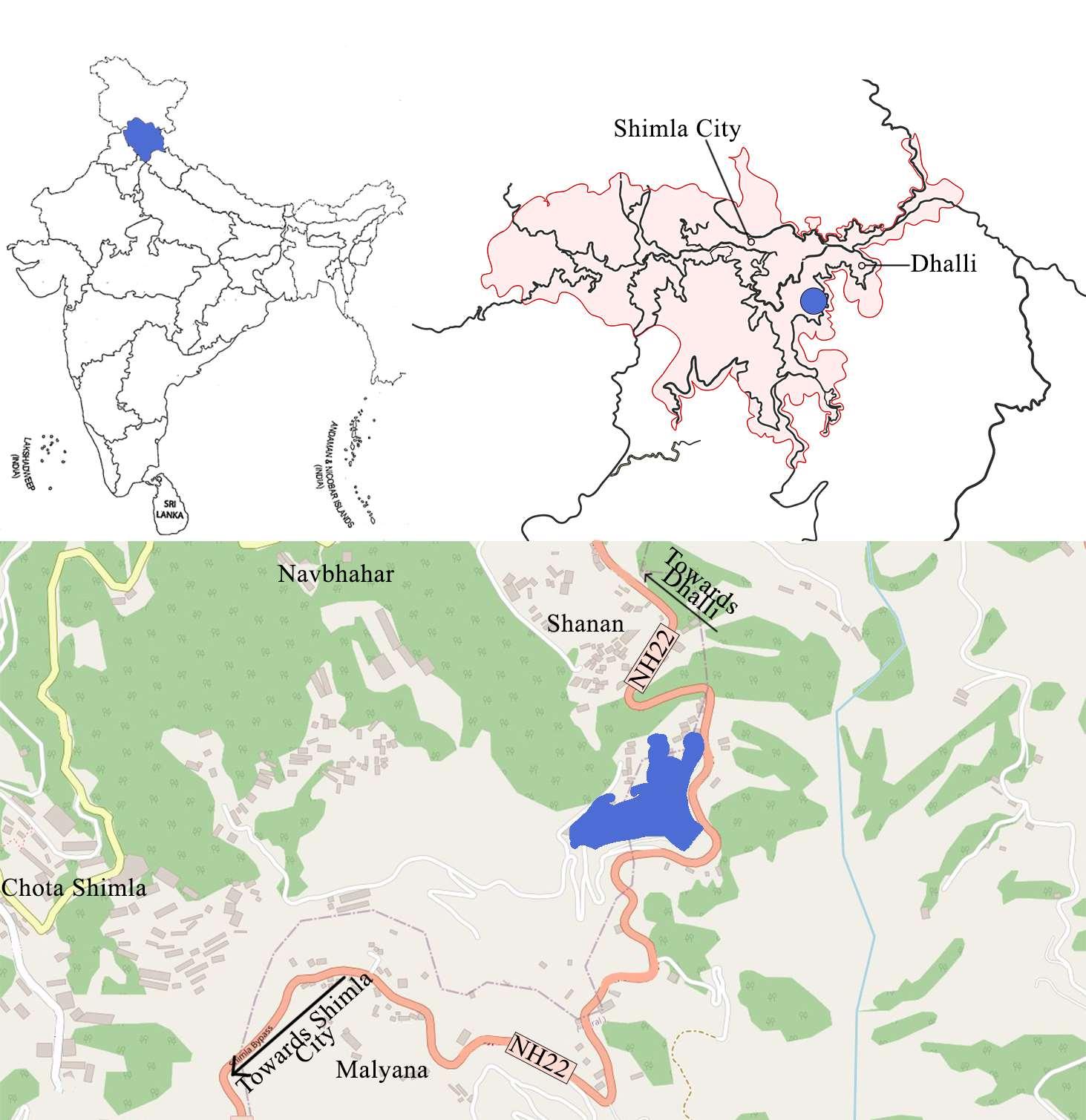
Figure2: Mapshowinglocationof(a)HimachalPradeshinIndia(topleftcorner);(b)map ofShimla(toprightcorner);(c)locationofsite inShimla(incyancolour)
5.1 ProjectBrief
SJVN Limited Corporate Headquarters consists of three buildings which are office, guest house and auditorium. There were two stagesof construction,the firststage consisted of an office building and in the second stage a guest house and auditorium are being constructed. The first stage started in 2011 and was completed in 2016. The second stage startedin2019andisstillunderconstruction(asof2023).
SJVN is very cautious about the environmental impact of its projects considering this, the whole project is being developed as a green project. As the office building was completed before the registration in GRIHA, it was registered in the GRIHA Existing Building category. The guest house and auditorium is registered under GRIHA- new projects as these buildings are under construction. So this paper only discusses about the firststagei.e.officebuildingasithasbeencertifiedunderGRIHA ExistingBuilding.
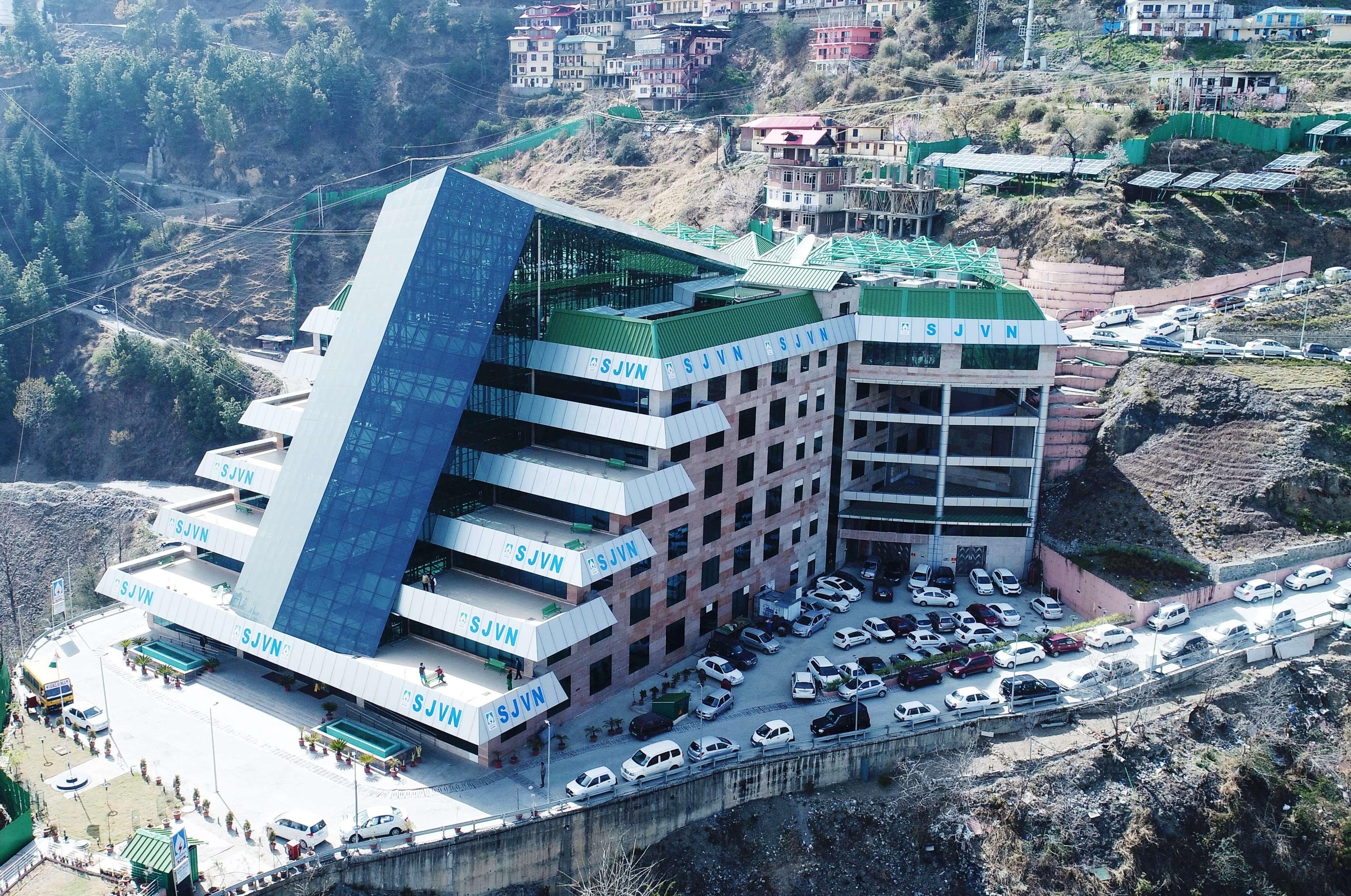
3: SJVNCorporateHeadquartersBuildingOfficeBlockbirdview
Table1: ProjectBrief ofSJVNCorporateHeadquartersBuilding
ProjectNameSJVNCorporateHeadquartersBuilding,Shimla,Himachal Pradesh
GRIHAprojectcode21EB0004
LocationShimla,HimachalPradesh
Numberofbuildingblocks03
Plotarea(sq.m.)29835.00
GroundCoverage(sq.m.)9737.60(32.63%)
AreaunderInternalRoads(sq.m.)5267.46(17.65%)
GreenArea(sq.m.)14829.94(49.70%)
Built-uparea(sq.m.)31733.03(32.58%)
ExistingOfficeBlock(1)14033.48
UnderConstructionBlocks(2)17699.55
5.2 AboutBuilding
1.The SJVN office building is a seven-story structure with escalators leading through the middle of the building to the top floor, thus creating an empty space in-between.
2.The building has been planned in a way such that it does not look like a typical rectangularofficebuilding.
3.Theatriumhasaglassroofprovidingnaturallightintothebuilding.
4.Motionsensorlightshavebeeninstalledtosaveonelectricity
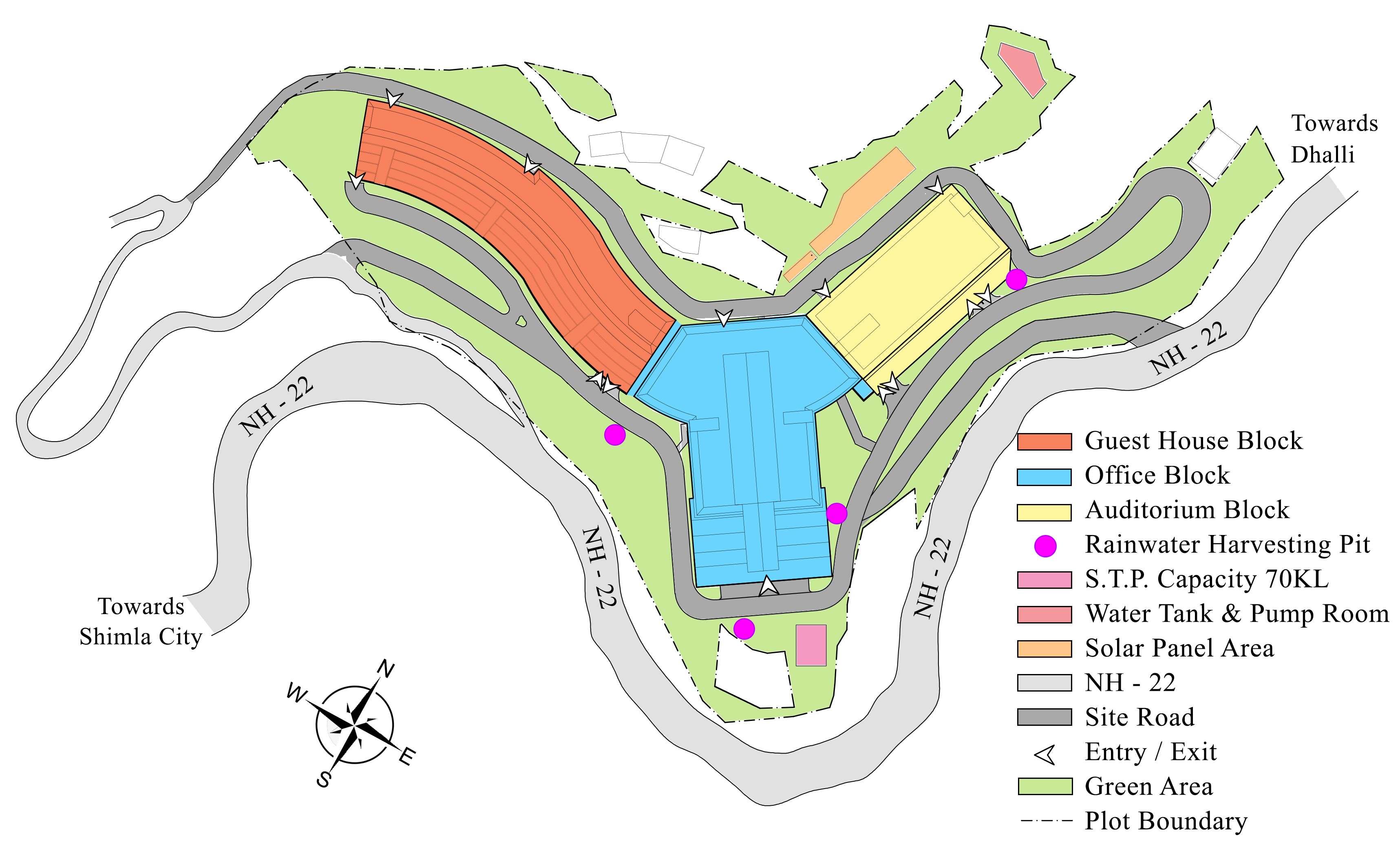
5.3 ProjectExplanation
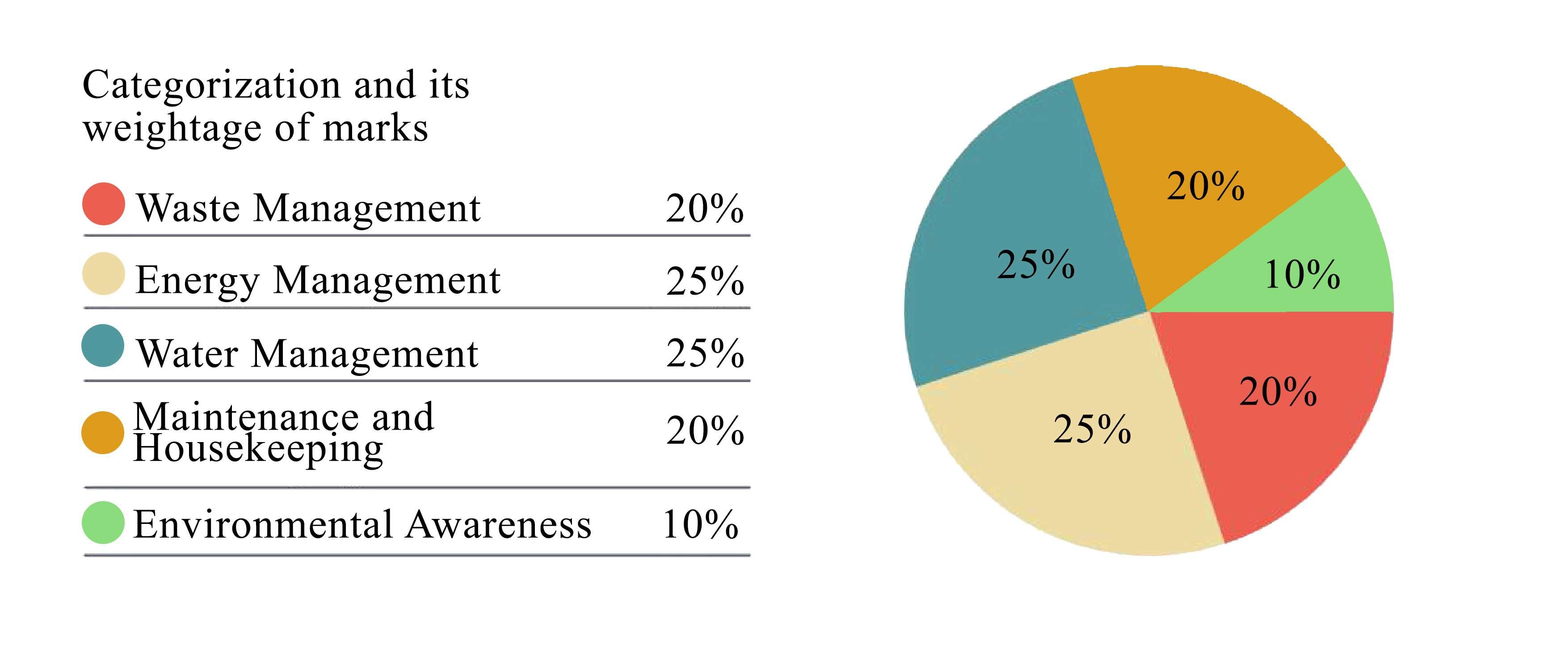
5: Categorizationanditsweightageofmarks


5.3.2 EnergyManagement (25% weightage)
The facility management team conducts regular preventive and corrective maintenance operations to ensure efficient working of the system and avoid energy loss. Additionalthird party energy audits are carried out frequently and the recommendations are carried to improve the energy savings of the facility. Policies are drafted to procure green and energy rated products. The project team needs to demonstrate optimization of energy consumption bytheuseofefficientappliances,use ofrenewableenergy,etc.
Totalannual energyconsumptionisoffsetthroughinstallationofrenewable energysourcesonsite(source,on-siteandoff-site generation)
Reductionofenergyconsumptionisachieved15.46%
TotalannualenergyconsumptionEXISTINGCASE–200111,50,190.45KWh/year
TotalannualenergyconsumptionBASECASE13,60,515.75KWh/year
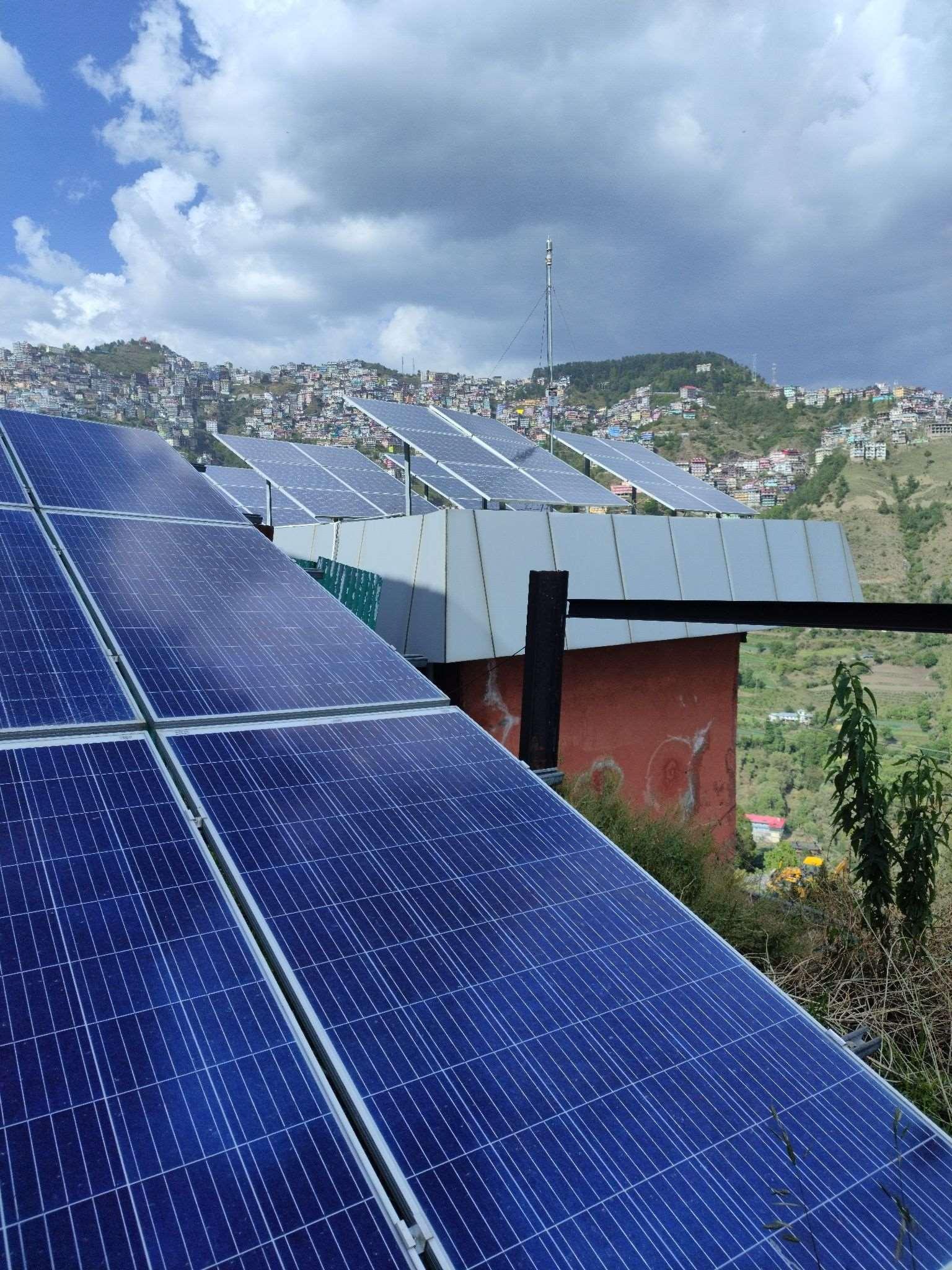

5.3.3 Water Management (25% weightage)
The facility has installed water efficient plumbing fixtures. Smart water metres are installed to log the water consumption pattern and to check leaks. The waste water generated is treated using an on-site STP plant and the treated water is re-used for irrigation. The project team needs to demonstrate the water saving, recycling and reuse on site(towardsnetzero/netpositiveapproach)
Table3: WaterManagement
WaterDemandside reduction64.29%
IrrigationDemandsidereduction83.25%
Quantity of treated water generated(Fixture, Cleaning, Vessel Washing & Misc.capacityofSTP 13kld,90%
Percentage ofwater treated100%
WaterFootprint(PlumbingFixture)2.94kl/capita/day
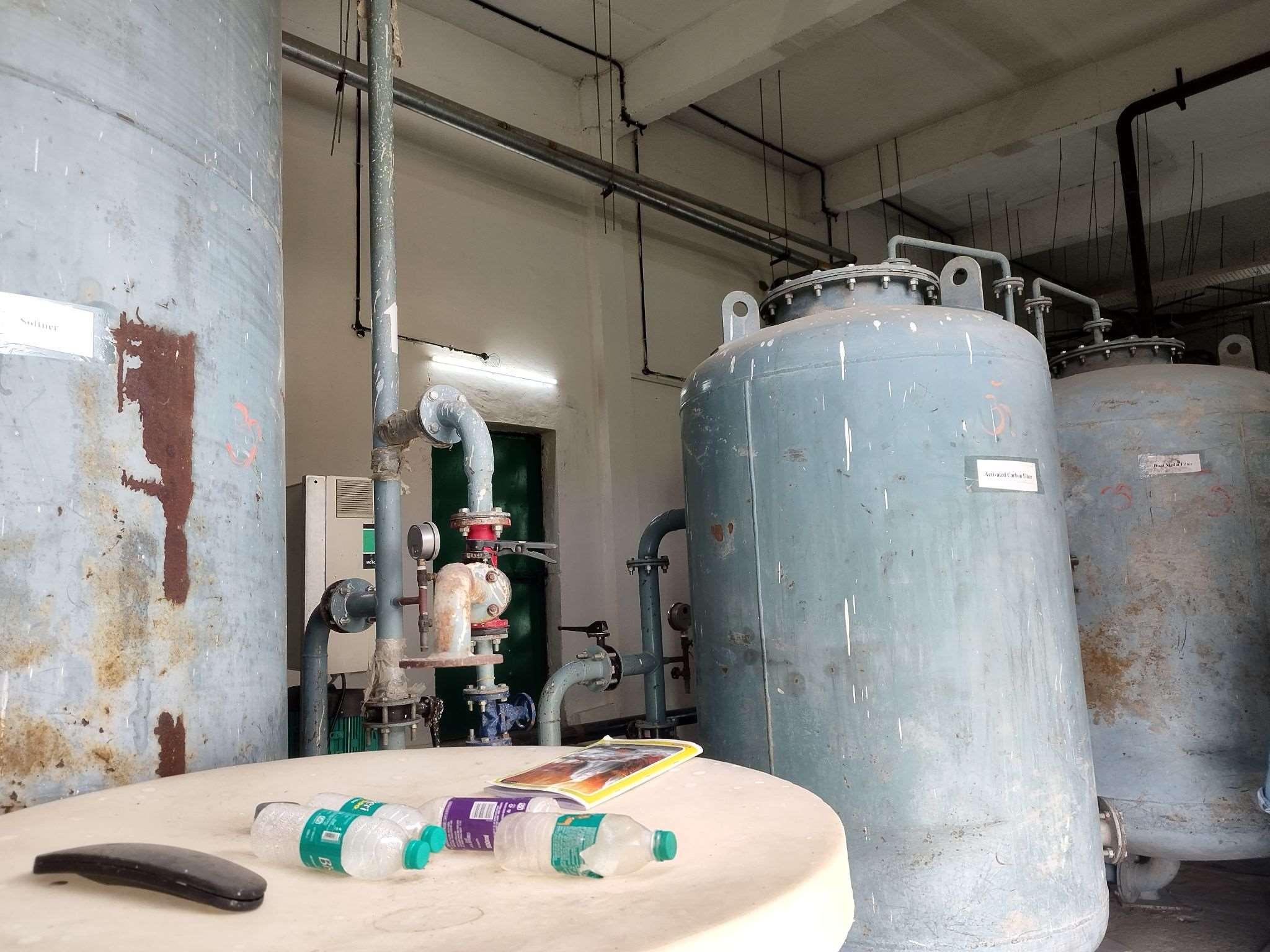
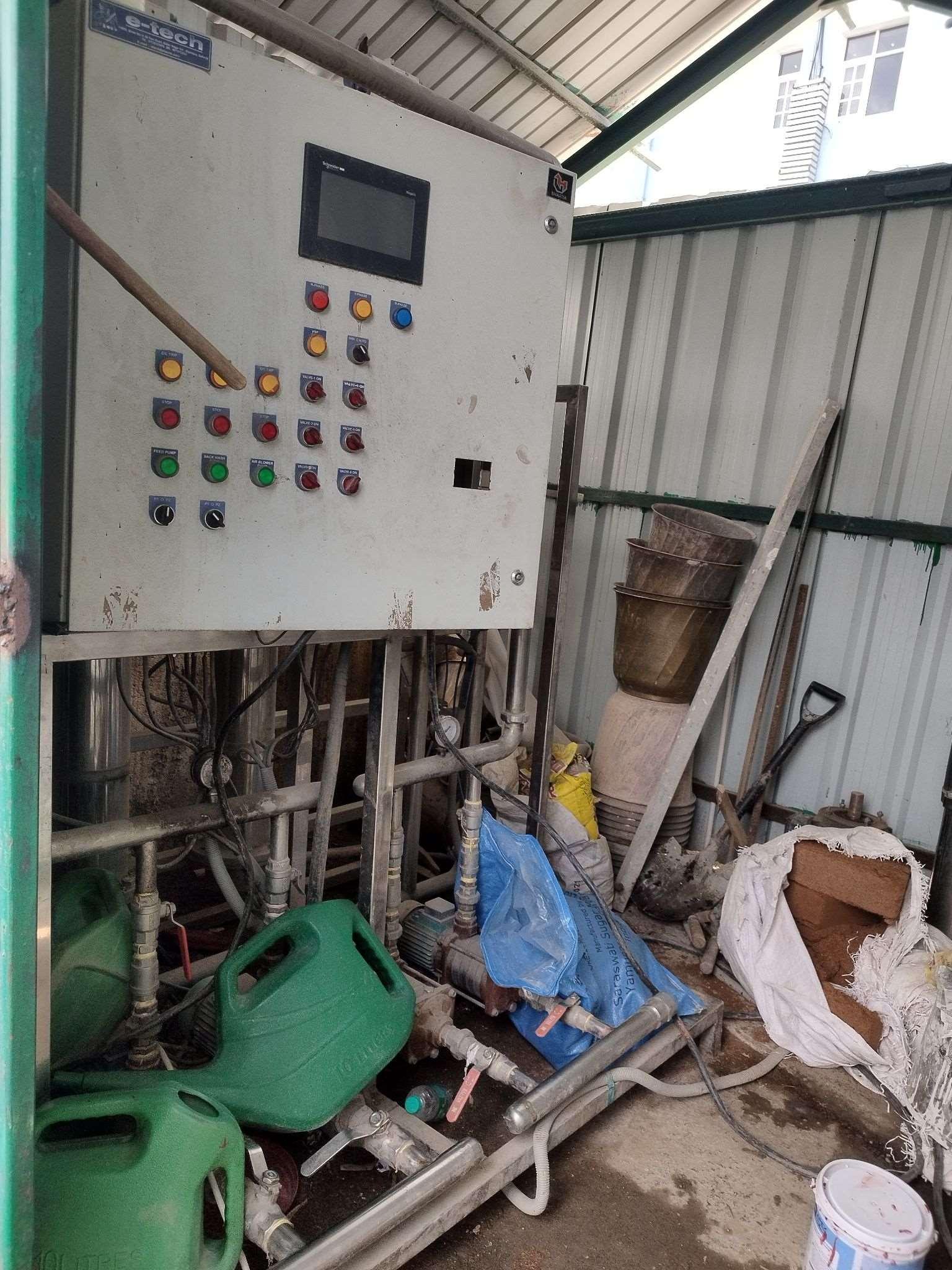


5.3.4 MaintenanceAND Housekeeping (20% weightage)
Utilisation of CFC/ HCFC free refrigerants and insulation to reduce impact on ozone depletion.The fireextinguishersusedarehalonfreeaswell. Allthecleaningproductsused are green certified and environment friendly. Annual maintenance contract has been maintainedforallelectro-mechanicalitemsusedinthefacility.
The project team must ensure good practices for maintenance and green procurement as asteptowardssustainability.
CFC-freeHVAC&coolingequipmentusedinthebuilding.
Table4: RefrigerantusedinHeatpump,Chiller,Firefighting
SystemHeat
RefrigerantR-410AR-134AAerosolGasSuppressionSystem
5.3.5 EnvironmentalAwareness (10% weightage)
In-house and neighbourhood activities to increase environmental awareness are being carried on a regular basis. Many tree plantations have been carried out as part of CSR activities. Measures such as putting up green education, signage and labelled water pipelines are maintained to increase awareness and responsible usage of resources by the buildingoccupants
Theprojectteammustsubmitstrategiestopromote environmentalawareness.
The building uses EKAM-CARE products which are Non-Toxic and made from natural ingredients. ThecompanyisCII-IGBC(IndianGreenCouncil) GreenProCertified.
5.4 AppraisalPointTable
SJVN office block scored a total of 73 points out of the total 104 points. With this the building was awarded Four star rating by GRIHA for Existing Building (See Table 5 below).
Table5: PointsscoredinGRIHA forexistingbuilding
SectionCriteriaPoint
SectionI. Site Parameters C1AccessibilitytoBasicServices22 Basicamenities11 CollectiveTransportService11 C2MicroclimaticImpact42 Numbersoftrees20 UrbanHeatIslandReduction22
SectionII. Maintenance & Housekeepin g C3Maintenance,GreenProcurement&Waste Management 77
EnvironmentFriendlyCleaningChemicals11
Policy-Purchase ofBEEstarratedappliances11 Multi-ColouredBins11
SpacetoSegregate&StoreWaste11
ContractualTie-Ups-WasteRecyclers11
treatOrganicWasteOn-Site22
C4Metering&Monitoring106
AdvancedMetering-Energy11
AdvancedMetering-Water11
AdvancedMetering-AirQuality11
One-WayMeter33 Two-WayMeter40
SectionIII. Energy C5EnergyEfficiency207 EEM-Implemented55
ReductioninEnergyConsumption152
C6RenewableEnergyUtilisation1515
SectionIV. Water C7WaterFootprint1513
ReductioninBuildingWaterConsumption33 minimiselawnarea22 waterefficientirrigationsystem22 On-Site STP44
Rainwaterharvesting42
C8ReductioninCumulativeWaterPerformance100
SectionV. Human Health& Comfort C9AchievingIndoorComfortRequirements (Thermal,VisualandAcoustic) 88 ThermalComfort22 ArtificialLighting22 DaylightFactor22 IndoornoiseLevel22
C10MaintainingGoodIAQ44 FreshAirQuality22 FreshAirQuantity22
SectionVII. BonusPoints C11UniversalAccessibility&Environmental Awareness 55 UniversalAccessibility22 EnvironmentalAwareness33
SectionVII. BonusPoints C12BonusPoints44 Organicwastemanagement22 Bio-diversitypark22
TotalPoints10473
5.5 Certificate
As per the GRIHA rating system for existing buildings the building scoring between 71 -85 falls under four star category. Hence four star rating was awarded to the projects. The certificate ofthesameisdisplayedasFig.10.
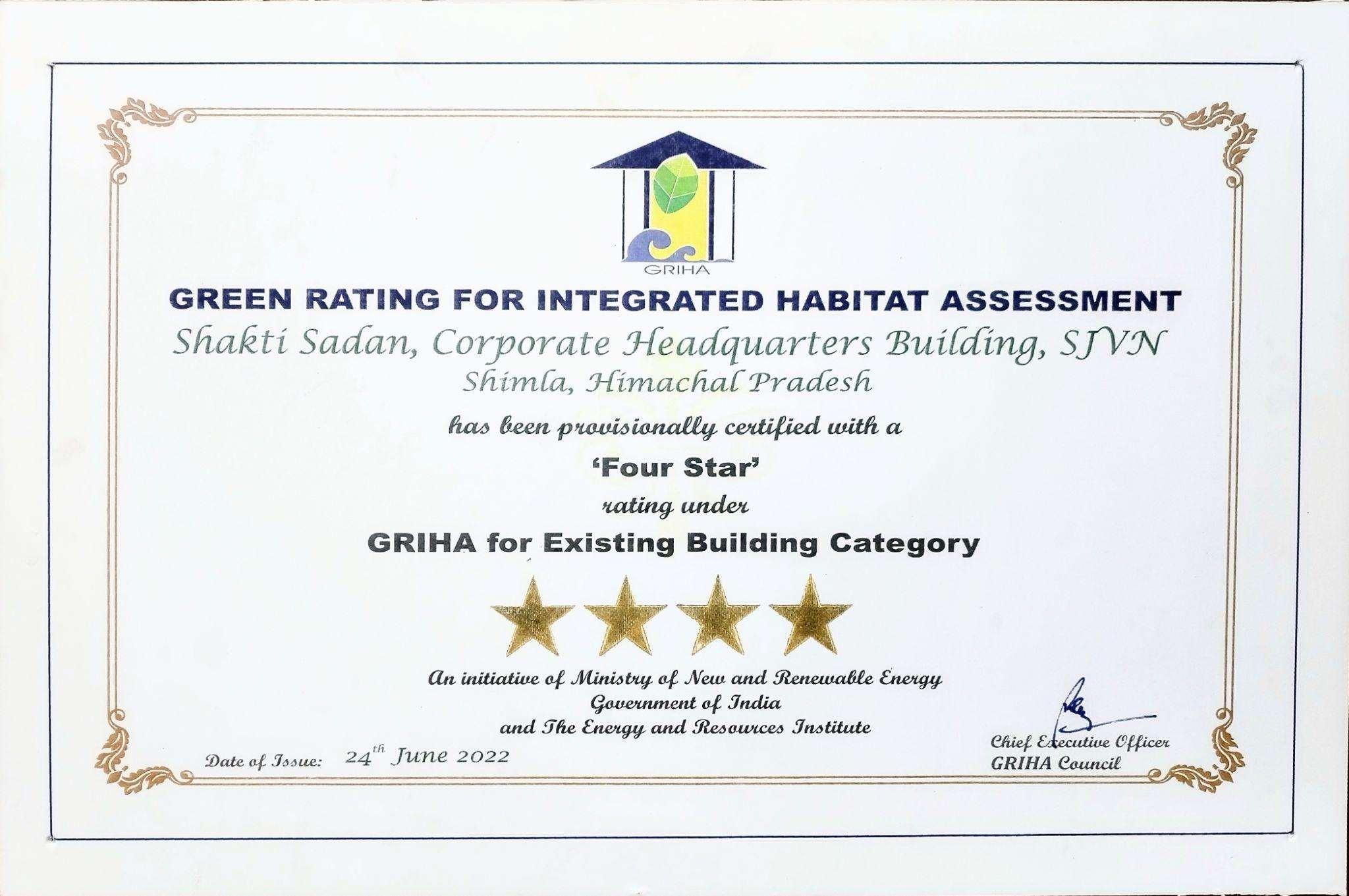
CONCLUSION
Growing awareness about green buildingsand sustainability has resulted in an environment where many individuals and organizationsare doing their bitto protectmother earth. SJVN is such one organization which is committed to the sustainability of the earth. SJVN is demonstrating commitments by employing green building technologies and solutions to most of its projects. Corporate Headquarters of SJVN is a perfect example in the region to demonstrate such commitments. At SJVN not only this building but all the infrastructural projectsare beingundertaken to protectsustainability ofmother earth.Though lotof efforts are being put in at individuals, organization, national and international levels, but there is lotmoretobedonetoachieve ParisAgreementgoalof limitingglobaltemperatureincrease towellbelow2degreescelsius,whilepursuingeffortstolimittheincreaseto1.5degrees.
REFERENCES
[1] Dubey, A., & Kamal, M. A. (2021, August 29). Analysis of GRIHA’s Variant for Large Development:CaseofEducationalCampusesinIndia.ScienceandEducationPublishing.
[2] Mokal,A.,.Shaikh,,.A.,Raundal,S.,Prajapati,S.,&Phatak,U.(2015,April). GREEN BUILDING MATERIALS – A Way towards Sustainable Construction (Vol. 4, Issue 4). International Journal of Application or Innovation in Engineering & Management (IJAIEM).
[3]Green Building |US EPA. (n.d.). EPA Archives. Retrieved April 25, 2023, from https://archive.epa.gov/greenbuilding/web/html/index.html
[4]A Green Building Overview. (n.d.). HGTV. Retrieved April 25, 2023, from https://www.hgtv.com/design/remodel/interior-remodel/a-green-building-overview
[5] Prakash, A., & Ravinder, R. (2018, June). Analysis On Green Building (Case Study: GRIET, Hyderabad, India). NATIONAL CONFERENCE ON WATER AND ENVIRONMENTALSOCIETY-2018.
[6] LEED rating system | U.S. Green Building Council. (n.d.). USGBC. Retrieved April 25, 2023,fromhttps://www.usgbc.org/leed
[7] IGBCRatingSystem-GreenBuildingRatingSysteminIndia.(n.d.).IGBC.RetrievedApril 25,2023,fromhttps://igbc.in/igbc/redirectHtml.htm?redVal=showratingSysnosign
[8] Certification. (n.d.). Home | Green Rating for Integrated Habitat Assessment. Retrieved April26,2023,fromhttps://www.grihaindia.org/
[9] Comparison of Green Building Standards | US EPA. (2022, May 12). Environmental Protection Agency. Retrieved April 25, 2023, from https://www.epa.gov/smartgrowth/comparison-green-building-standards
[10]GRIHA V.2019 Volume 1 [IntroductiontoNationalRatingSystem-GRIHAAnevaluation tool to help design, build, operate, and maintain a resource-efficient built environment]. (2021).TheEnergyandResourcesInstitute(TERI)TERIPress.
[11]GRIHA EB [GRIHA for Existing Building]. (2017). In version 1. The Energy and ResourcesInstitute(TERI)TERIPress.
[12]Press Release Detail.(n.d.).SJVNCorporateHeadQuarters“SHAKTISADAN”Becomes FirstBuildinginHimachalPradeshtoobtainFourStarGRIHARatings.RetrievedApril26, 2023,fromhttps://sjvn.nic.in/press-release-detail/1940/42
